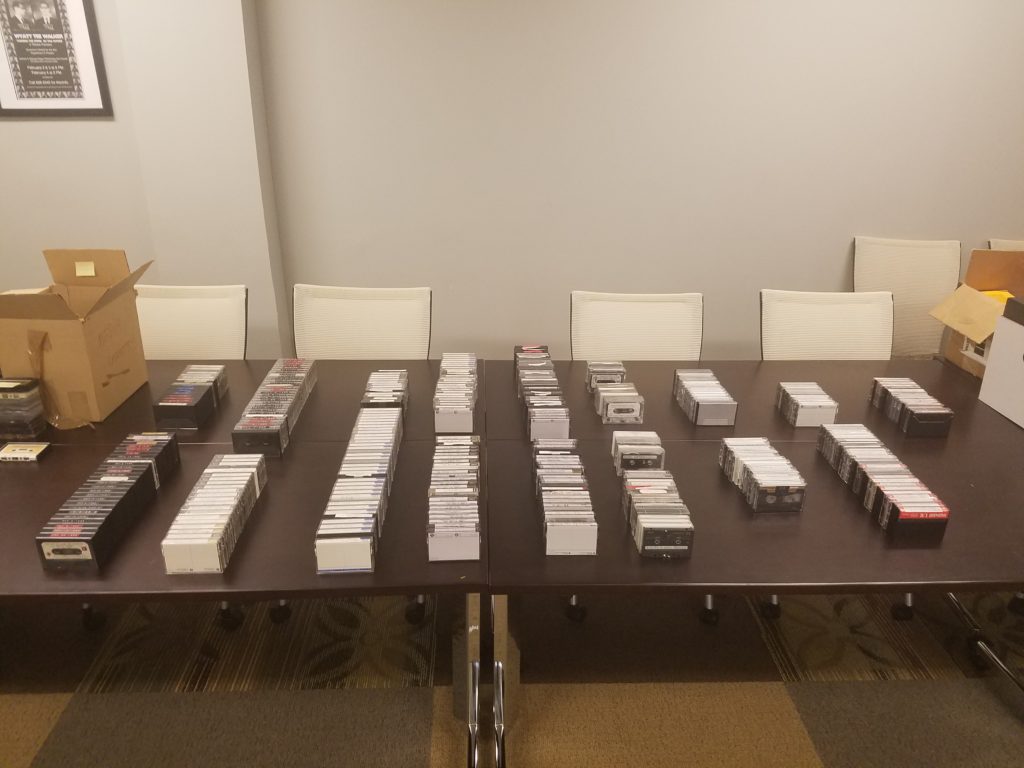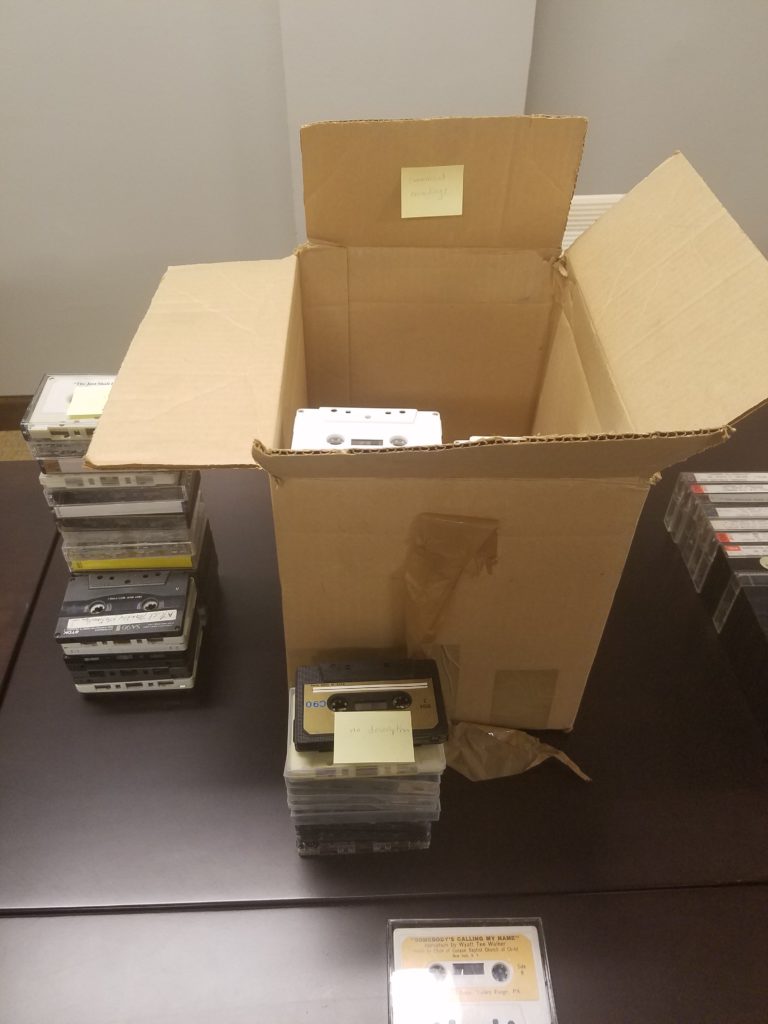(Note: This post was authored by Taylor McNeilly, Processing & Reference Archivist.) Happy #WyattWalkerWednesday! (Editor’s note: due to technical difficulties with the blog, this week’s post didn’t go up until Thursday. Our apologies on the delay.) This week, I’ve been continuing my work on processing the audio cassettes in the Dr. and Mrs. Wyatt Tee Walker Collection to prepare them for digitization with our vendor.
As I mentioned last week, we’ve begun to move forward with digitization of the audio cassettes (about 800 of them) as well as a small number of 8mm and 16mm films. We also recently found a reel-to-reel audio reel dated 1967, which will be digitized as well. This material was prioritized for digitization due to the average lifespan of magnetic tape media, generally considered to be 10-30 years. We are still hopeful that the earliest tapes from the 1960s and 1970s will still have enough audio integrity to be digitized, but obviously needed to move on this as quickly as possible.
Thanks to the hard work of our student workers who created the original inventory of audio cassettes, we were able to get several competitive quotes from various digitization vendors. In the end, we selected a well-known vendor who has worked with LYRASIS (the hosting company for ArchivesSpace), the Library of Congress, and other well known, high quality institutions. Several Boatwright Library staff have also worked with the vendor at previous jobs, so we have high confidence in their work.
Unfortunately, the inventory the student workers created was not in the order in which the cassette tapes were arranged. This means that, in order to have the audio cassettes packed and listed in the same order, both the inventory and the physical cassettes need to be rearranged into the same order. Since they will be digitized and the files named in the order that they are received, it makes things much easier moving forward with handling the digital files if they’re organized into a logical and consistent order. Because of this, my boss Lynda and I put our heads together to make sure we started this project out on the right foot with this cassette arrangement work.

Audio cassette tapes from the Dr. and Mrs. Wyatt Tee Walker Collection being arranged into chronological order.
After discussing our options, Lynda and I agreed that the following order makes the most sense. Because some of the cassette tapes appear to be commercially produced, we don’t hold the copyright and digitizing and making them available online would move the library into some murky waters. These were separated out from the other tapes in order to be addressed by the vendor more easily. The remaining recordings, according to their labels, appear to be primarily sermons Dr. Walker gave on Sundays. In fact, we seem to have a nearly full run of every single sermon he gave between 1984 and 2002. (My arrangement work isn’t yet finished, so I can’t say with certainty if we have them all or not just yet.) I am arranging the sermon tapes into chronological order, allowing them to be digitized and easily made available online in the most straightforward way. This will allow future listeners to follow Dr. Walker’s sermons through time, creating the easiest way to trace his development as a theologian and pastor.

Audio cassette tapes from the Dr. and Mrs. Wyatt Tee Walker Collection that were either commercially published, undated, or unlabeled.
However, not all cassette tapes are so easily arranged. There are quite a few that are labeled with the title of the sermon, but only a month and year. Others have no date at all. And some have no descriptive information at all, leaving us with no guess as to what it might contain or when it was recorded (although comparing the physical cassette to labeled and dated cassettes can give us an estimate on the when, at least to within a few years). These tapes were separated out as well, into one pile of labeled-but-undated and another pile of completely-unknown. The vendor will receive the sermons in chronological order, followed by labeled-but-undated, followed by complete-unknown, and finishing with those tapes that appear to contain copyright material. This allows us to more easily manage the digital files, meaning it’s much faster and easier work to get them available online to researchers – always a major focus on digitization projects in particular and processing work in general.
It’s important to note that audio cassettes are a lot like folders in a filing cabinet. While it makes sense to have labeled a folder and kept its intended contents within it, occasionally people reuse old folders for new material – meaning the label might not be accurate anymore. Cassette tapes are similar, although the tendency to record over might perhaps be a bit stronger: brand new cassettes cost a bit more than brand new folders, after all. This is why we’ll be sending the commercially recorded cassette tapes for digitization; you never know if they’ve been overwritten with something. And of course, the same goes for the chronologically ordered sermons. There’s nothing to say that they weren’t accidentally recorded over, like when a children’s program is stuck onto your favorite movie’s VHS (sorry, kids, you probably don’t understand that one!).
Work on arranging the cassette tapes, arranging the list to match, and packing the tapes is ongoing. I’ll of course keep you all updated on progress, so look for more posts in the future!
